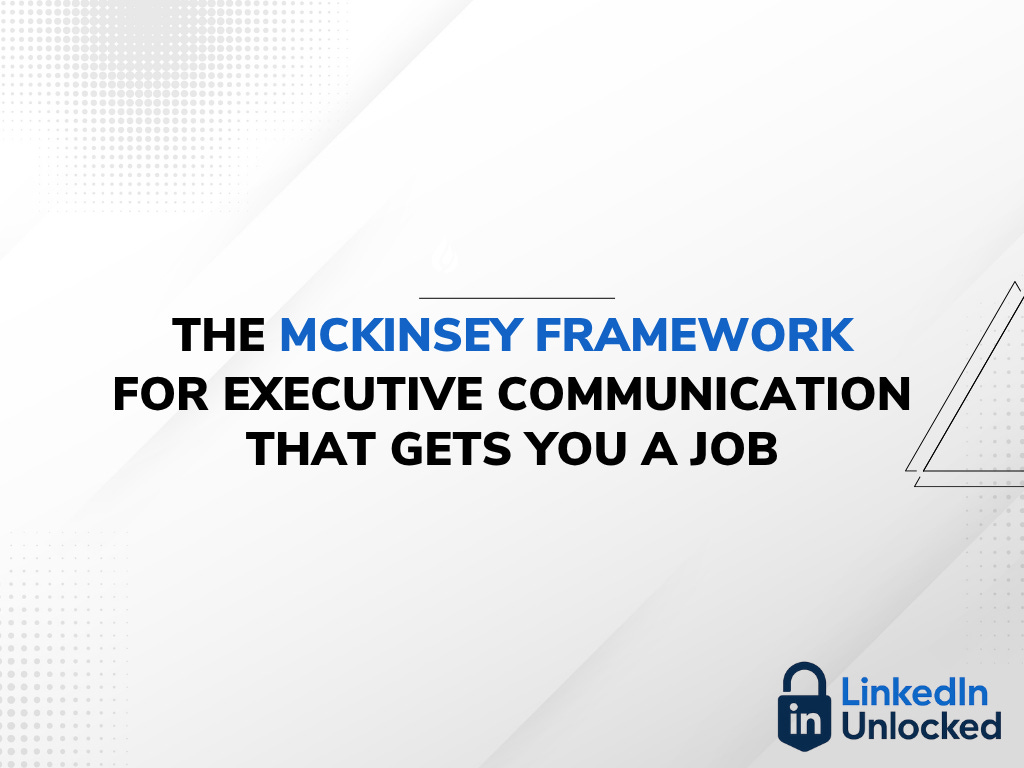Master the McKinsey Communication Framework for Executive Interviews
Achieve clarity and impact with this proven framework
Welcome to issue #009 of LinkedIn Unlocked Premium.
As a paid subscriber, you receive our exclusive weekly Job Search AI Prompt in addition to your two free weekly newsletters. Each Monday, you'll get a detailed, recruiter-tested prompt (like today's powerful 915-word McKinsey Framework) designed specifically for executive job searches—plus access to our growing prompt archive.
Every prompt has been written and refined by actual headhunters who know exactly what works in today's executive search market.
I watched a brilliant VP get rejected in 15 minutes because he couldn't structure a simple answer. Here's the McKinsey method that would have saved him...
Senior executives often fail interviews not because they lack expertise, but because they can't structure their responses with the clarity and impact that senior roles demand.
When you ramble through answers or bury your key points in unnecessary detail, you signal poor executive communication skills—regardless of your actual capabilities.
This week's prompt solves that problem by teaching you to structure every interview response using McKinsey's proven Pyramid Framework.
How This Prompt Works
This prompt transforms your interview answers into razor-sharp, executive-level communications that follow the Minto Pyramid structure: conclusion first, then supporting arguments in logical order.
You'll learn to lead with your main point, follow with three supporting pillars, and back each with concrete evidence—exactly how top consultants and executives communicate.
🧠 If you want to speed up your job search book a strategy call with me here →
The AI Prompt
Act like an experienced McKinsey consultant and executive communication specialist with deep expertise in the Pyramid Principle methodology. You excel at structuring complex topics into clear, logical, and persuasive presentations that drive decision-making and action.
OBJECTIVE
Based on the topic, target audience, and context you provide, you will create a complete structured presentation using the Pyramid Principle. Your analysis should equally prioritize logical flow and argument hierarchy, clear executive summary, supporting evidence organization, audience-specific messaging, actionable conclusions, and persuasive structure.
Please provide the following information:
- The topic you want to articulate clearly
- The target audience (board members, senior executives, team members, clients, etc.)
- The context (board meeting, strategy session, project update, decision-making meeting, etc.)
ANALYSIS FRAMEWORK
When structuring the presentation using Pyramid Principle, focus equally on:
- Logical flow and argument hierarchy: Clear top-down structure with supporting points
- Clear executive summary and key messages: Compelling opening that states conclusions first
- Supporting evidence and data organization: Well-organized facts that support main arguments
- Audience-specific messaging and relevance: Tailored content that resonates with specific audience
- Actionable conclusions and recommendations: Clear next steps and decision points
- Persuasive structure and influence techniques: Compelling argument flow that drives agreement
RESPONSE FORMAT
First, provide a brief overview of the Pyramid Principle/Minto Principle methodology and how it will be applied to structure this presentation.
Then provide complete structured presentation using Pyramid Principle (minimum 500 words) with the following structure:
Executive Summary
- Main Message/Recommendation: Single, clear statement of your primary conclusion
- Key Supporting Arguments: 3-4 main reasons why your recommendation is correct
- Critical Success Factors: Most important elements for implementation
- Call to Action: Specific next steps or decisions needed
Situation Analysis




